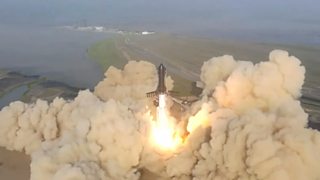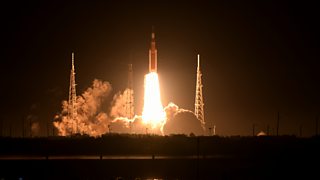

SpaceX’s enormous Starship rocket is the largest to ever successfully leave the launchpad. The massive thrust needed to launch it creates a lot of noise – but is it the loudest rocket ever?
Watch footage of the Saturn V launches during Nasa’s Apollo programme in the 1960s and 1970s, and one thing that may strike you – even more than the polyester-heavy fashions and retro haircuts – is just how far away the crowds of onlookers are from the main event.
There were several good reasons for this, and noise was one of them: loud sounds can kill, and few things built by humans have been as loud as the Saturn V.
When Apollo astronauts blasted off on their missions to the Moon, they did so with more than 3.2 miles (5.1km) separating them from the excited, onlooking crowds. Even at such distances, the noise was incredible. A common myth at the time was that the soundwaves from the Saturn V’s engines were so powerful that they melted concrete on the launch pad and set fire to grass a mile (1.6km) away (both were false).
Nasa’s measurements at the time captured the launch noise at 204 decibels. Compare that to the sound of a jet airliner taking off, which is between 120 and 160 decibels and considered dangerous to hearing if endured for longer than 30 seconds. Even 1.5 miles (2.4km) away, the noise from a Saturn V launch was recorded as being 120 decibels – as loud as a rock concert, or a car horn at very close quarters.
“I’m always struck by the physicality of a launch,” says Anthony Rue, a Florida café owner who has been watching and photographing launches since the days of Saturn V. “Back in the 1970s there was an audio device called Sensurround that was used in disaster movies like Earthquake to create a subsonic seismic ‘experience’ in the theatre.

“Launches, from up close, are a bit like Sensurround,” says Rue. “You can feel a slight tremble, then a building rumble in your chest before you can hear any actual sound. The subsonic bass frequencies make your ears crackle. After a few seconds, the sound coalesces into a roar, like a massive welding torch.”
Last year, a team of scientists from Brigham Young University in Utah calculated just how loud Saturn V was. They came up with a remarkably similar finding to Nasa’s own recordings – 203 decibels.
The difference between 160 and 200-odd decibels might not sound like a lot in the grand scheme of things, but it is.
“One hundred and seventy decibels would be equivalent to 10 aircraft engines. Two hundred would be 10,000 engines,” said Kent Gee, leader author of the study and professor of physics at the Brigham Young University at the time. “Every 10 decibels is an order-of-magnitude increase.”
Was Saturn V the loudest rocket ever launched? Probably not, if you use thrust as your guide. The 35MN (meganewtons) of force produced by Saturn V at launch is less than that produced by the Soviet Union’s ill-fated N1 rocket (45MN) which was supposed to have delivered cosmonauts to the lunar surface in the 1960s.
The 33 engines at the base of the Super Heavy booster on SpaceX’s Starship – the largest rocket to ever take off – produce more than 74MN of thrust. On paper at least, it should be louder than anything launched before it. Certainly, it is pretty loud. Gee and his colleagues set up microphones at eight sites around the SpaceX launch facility in Boca Chica during the fifth test flight in October 2024, when the Super Heavy booster also landed back on the launchpad for the first time. They found that during the launch, the rocket produced noise that reached more than 120dB more than 6.5 miles (10.5km) away. A sonic boom produced as the booster returned towards the launchpad generated almost 140dB at the same distance.
The overall noise produced a Starship launch at that distance was equivalent to standing just 200ft (61m) from a large passenger aircraft such as a 747 or A380. Gee and his colleagues describe the sound produced by a rocket launch as low-frequency rumble with transitory crackles. The noise of the Starship launch set off car alarms in towns upto 10 miles (16km) away.
While it is hard to know for sure how the noise produced by the Saturn V would have compared, it was certainly loud enough that there was more to consider than just the hearing of spectators. Rockets as powerful as Saturn V were capable of causing damage to themselves just from the soundwaves generated from the noise of their own launch.
I’m about a half mile away, I’ve got earplugs in and for 600 seconds, this thing is producing just more steam than you can imagine – John Blevins
Making sure that damage didn’t happen preoccupied Nasa’s rocket engineers even before the Apollo programme, says Nasa’s John Blevins, chief engineer of the Space Launch System (SLS) used for the recent Artemis programme launch.
One solution: the fire trenches in the launch pad are filled with water which helps muffle some of the intense noise created when the rocket lifts off.
“There’s a series of ground tests that we did back in the Apollo days, we did them again for Space Launch System,” says Blevins, adding that Nasa also built smaller models of both the rocket and the pads to gauge how their interactions produced noise. “The maximum noise for the rocket itself, although you might not be able to tell if you’re sitting at Banana Creek [a popular site for viewing launches], is actually about 150ft (45m) off the ground; the plume is spread out, instead of going down a hole that has the water in it, that helps attenuate some of that noise.”
The biggest rocket ever launched
The Starship rocket, built by Elon Musk’s SpaceX, became the largest and most powerful rocket system to ever take off when it launched on its brief maiden flight on 20 April 2023 moments before it underwent an “unscheduled disassembly” while in mid-air. The 120m (393ft) tall rocket is designed to have almost double the thrust of any rocket in history.
Analysis conducted by the US Federal Aviation Administration (FAA) prior to Starship’s launch estimated the Super Heavy rocket system would produce up to 150dB in the area just outside the Boca Chica Launch Facility in Texas. People up to eight miles (13km) away, including those living in nearby Port Isabel, will hear the roar of the rocket at a level of 120dB, while those in eastern Brownsville around 15 miles (24km) away will experience noise levels of 111dB – around the same as being at a live rock concert. Measurements taken during the fifth test flight of Starship by researchers at Brigham Young University showed that the maximum noise produced were close to these preditions.
The FAA warned the engines may even be loud enough to damage to nearby buildings. Residents in Port Isabel reported doors and windows shaking, and one gym owner claimed his window shattered during one Starship launch, according to the New York Times. Dust and debris kicked up by the rocket also rained down on the town and the launchpad itself was destroyed by the force of the rocket.
The water-filled fire trenches were also used for the Space Shuttle launch – the charismatic, boiling clouds of vapour seen in those famous old Nasa rocket launches are not in fact smoke, but steam from the water vaporising from the intense heat.
You might also like:
The SLS is the new rocket used in the Artemis programme – the one planned to take humanity further into the Solar System than ever before. It became one of the most powerful rockets ever launched with 15% more thrust than Saturn V. As the SLS chief engineer, Blevins has watched – and heard – its five engines being ground tested at the John C Stennis Space Center in southern Mississippi. The ground tests are a critical step in a rocket design’s progress, says Blevins.
“I’m about a half mile away, I’ve got earplugs in and for 600 seconds, this thing is producing just more steam than you can imagine. And when you can get that close, you see that’s one engine out of four! And those produce less thrust than the two [solid rocket boosters] on the side.
“It gives you an idea just how powerful these rockets are. It’s just amazing.”

Blevins says the SLS is designed to be quieter than Saturn V, but that noise levels are dependent on more than just the engine’s thrust.
“There’s a lot of nuances to what the people hear,” says Blevins. “Like a low cloudy day, like if you had a 1,000ft (330m) cloud ceiling, that noise will travel all the way across the state of Florida and just bounce back and forth. It really won’t be easily attenuated and so people in Tampa will hear a rocket launch if you have a little overcast day.” Tampa is three hours’ drive away from the Kennedy Space Center, on the other side of the Florida peninsula.
A study by scientists at Brigham Young University and Rollins College in Florida studied recordings from the SLS during the Artemis 1 launch in November 2022 found it made more noise than pre-launch models had predicted. They found at 0.9 miles (1.5km) from the launchpad, the maximum noise level reached 136 decibels while at 3.2 miles (5.2km) it was 129 decibels.
Whitney Coyle, a mathematician at Rollins College who studies acoustics and was one of those who examined the sound coming from the Artemis 1 launch, described the crackling sound the SLS produced as being “40 million times greater than a bowl of Rice Krispies“.
Noisier rockets may be on the cards though. SpaceX’s Starship vehicle – intended for a proposed mission to Mars – took off on top of the company’s Super Heavy booster on its brief maiden flight on 20 April 2023 amid a huge plume of flame and smoke. Super Heavy can, according to SpaceX, generate nearly 76MN of thrust, more than twice that of Saturn V. SpaceX’s engineers now have to figure out why the rocket underwent a mid-air “unscheduled disassembly” shortly after take-off before the giant rocket will fly again. But if you’re planning on watching its next launch, earplugs sound like a very good idea.
* This article was originally published on 7 March 2023 but was updated on 19 November 2024 to include details from a study on SpaceX’s Starship launch.